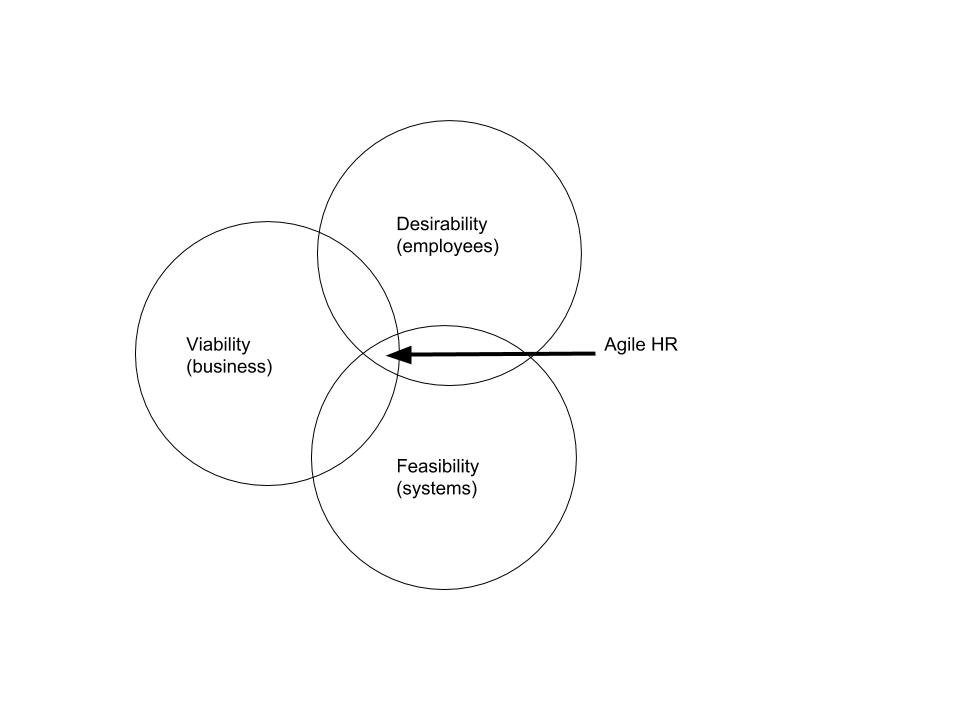There has been a lot of buzz recently about how HR needs to re-invent itself and be Agile. In HR Goes Agile, Peter Cappelli and Anna Travis call out that HR is moving away from a “rules - and planning-based approach toward a simpler and faster model driven by feedback from participants.”
Agile seems to be the coolest kid on the block. What started out as a software development practice has now stretched beyond product, to how organisations operate. The challenge is that traditional Agile has a certain structure and ceremonies associated with it which leave some business professionals wondering what this means for them. However, if you get past sprints and standups, what Agile is really about is listening, testing and iterating. It’s a constant evolution, adapting to the needs of the employee (desirability), business (viability), and systems (feasibility).
So what does this mean for HR? HR has traditionally been about policies and procedures. It originated as a function to hire people, protect the business interests and help mitigate risk. That model is outdated, and as highlighted in Bright, Shiny Objects and the Future of HR, HR needs to “fall in love with the problem, not the solution.”
Bringing Agile to HR means first focusing on all of your employees. Whatever you create or implement should make their lives easier, reduce friction and hopefully bring a bit of delight.
Next, you need to understand your business’ commercial needs and pain points. Where are you most vulnerable when it comes to your employees? Is your attrition rate high? Are talented people leaving because they don’t have the autonomy they need to thrive?
Finally, you need to look at your existing systems, policies and procedures. What are you able to change? What will you have to work around? Are there procedures you can remove to create less friction?
At ustwo Sydney, we’ve taken an Agile approach to HR. When the Sydney studio started, we had very little to no formal HR practices. We were running lean like a startup, but our employees kept asking “how do I know what to work on? How do I get better?” With this problem in mind, we wanted to introduce some more formal feedback.
We analysed our needs in terms of their desirability, viability and feasibility.

Desirability: We wanted to provide clarity for ustwobies on what they were doing well and what to improve. This is important for an employee to feel engaged in what they’re doing and helps with employee retention. Because our employees work onsite with clients in multi-disciplinary teams, we needed to be sure ustwobies got feedback from the people they were actually working with rather than only their manager. Being a culturally flat (non-hierarchical) organisation meant that we wanted the feedback to go up as well as down and across.
Viability: We needed the feedback to be fairly frequent, without creating too much of an administrative and time burden. In our industry, time is money so we needed to keep our costs down.
Feasibility: We were already using CultureAmp for our global studio engagement surveys, so we used the existing platform for our 360s. If you already have a system in place, us it first. If it doesn’t suit your needs, then you may want to consider alternative systems.
After addressing these different needs, we decided to introduce 360 reviews and run them every 6 months. Why did we choose this approach? 360 reviews allow feedback from managers, peers and direct reports. Annual reviews are problematic because too much happens in 12 months. Quarterly reviews would be great from a frequent feedback perspective, but the administrative and time burden would be huge (not to mention costs). Thus, we landed on reviews every 6 months. This doesn’t mean feedback shouldn’t happen more frequently, but in terms of formal, written feedback, 6 months is the right cadence for us.
We launched the 360 and had everyone go through the process. We used CultureAmps’ standard review format to get a baseline with minimal effort. Then, we got the whole studio together to do a timeline retro (retrospective) identifying highs and lows along the journey. One pain point was the structure of the review - it wasn’t specific enough to ustwo. The time commitment was another factor. Although we tried to control the amount of time required, some people had a large number of reviews to do. And finally, the quality of the feedback varied depending on who reviewed you.

Keeping an Agile frame of mind, we took all of this fantastic information and qualitative data and made changes to our next round 6 months later. We changed the review format to be more focused on ustwo competency areas and we limited the amount of reviewers to reduce the time burden. We had also spent the months between reviews doing a lot of upskilling across the studio on giving and receiving feedback.
Did we ace it the second time around? Not quite, but overall people got a lot more value out of the feedback. Did we say, “that’s great, we’ve got our 360 review process sorted?” Not even close. We ran another retro with everyone and got new insights into people’s highs and lows. Which means, hopefully, our next review will be better than the last.
What we did do is we listened, learned, and iterated and we will keep doing that. That is what Agile HR means. It means that even if you have something that works well, you should revisit it to see if it is still relevant. Does this still help your employees? Does this provide clarity and support? Is this a good use of time and money from a business perspective?
What can you change, add or subtract?
